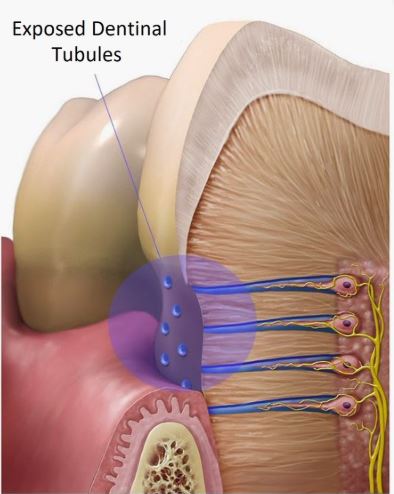Dental Hypersensitivity is one dental condition which almost everyone of us has faced at one point of time, it can be due to multiple reasons leading to the exposure of Dentin and dentinal tubules to the external thermal, mechanical, chemical and osmotic stimuli leading to hypersensitivity. Laser or Light Amplification by Stimulated Emission of Radiations has been identified as a potential treatment for Dentin Hypersensitivity in 1985 which has been tested with many studies to confirm its efficacy.
How is Dentin Hypersensitivity caused?
Hydrodynamic theory is the most accepted which denotes that the flow of dentinal fluid inside the dentinal tubules due to the pressure differences in the surrounding tissue affect the flow of the fluid either inward or outward. This flow stimulates the mechanoreceptors in the intratubular nerves and the superficial pulp leading to sharp pain in the patients often referred to as Hypersensitivity. Once Enamel is lost, dentinal tubules are exposed to the external stimuli leading to changes in the flow of dentinal fluid flow resulting in hypersensitivity.
Most common types of Lasers used in treatment of Hypersensitivity are – GaA1As diode laser with wavelengths between 780-900 nm act at the nervous level. Medium powered lasers – Nd:YAG, CO2 and Er:YAG laser.

How does Dental Laser treat Dentin Hypersensitivity?
The various modes in which Lasers are used to treat hypersensitivity has been tested in various publications as follows:
- Sealing of Dentinal tubules by melting and re-solidifying dentin (Er, C:YSGG Laser)
- Obliteration or Blocking dentinal tubules with tertiary dentin formation (Nd:YAG laser)
- Inhibition of nerve transmission to achieve analgesic effect
- Vaporization of dential fluid from tubules: Er, Cr.YSGG laser
The most common method used to treat Dentinal Hypersensitivity in Clinics is with the use of a Desensitizing agent – Gluteraldehyde with Hydroxyethyl methacrylate. Gluteraldehyde blocks the Dentinal tubules and prevents the hydrodynamic mechanism from happening thus leading to reduction in sensitivity.
How do you measure Dental Hypersensitivity?
It is measured using the traditional subjective measurement determined from patients symptoms. The other method is canned as Visual Analog Scale or VAS which help in determining using the patients response.
Yeaple pressure-sensitive probe is a more objective based measurement which uses sound controlled standardized probing pressure to determine the sensitivity.
Which is the best treatment for Dental Hypersensitivity?
According to the studies and research conducted over the years it has been determined that Reduction in Sensitivity is achieved equally using both types of lasers. The studies also tried using Laser therapy in combination with the tried and tested GCA application which has yielded the most effective results – Er, CrLYSGG laser + Gluteraldehyde.
Certain Research papers have considered the importance of Placebo Effect in cases of Dentinal Hypersensitivity which can play a major role in the patients response to stimulus. Psychosomatic component of dentinal hypersensitivity should be considered and it is observed to play a major role in treatment with Lasers in DH.
References:
Leave a Reply